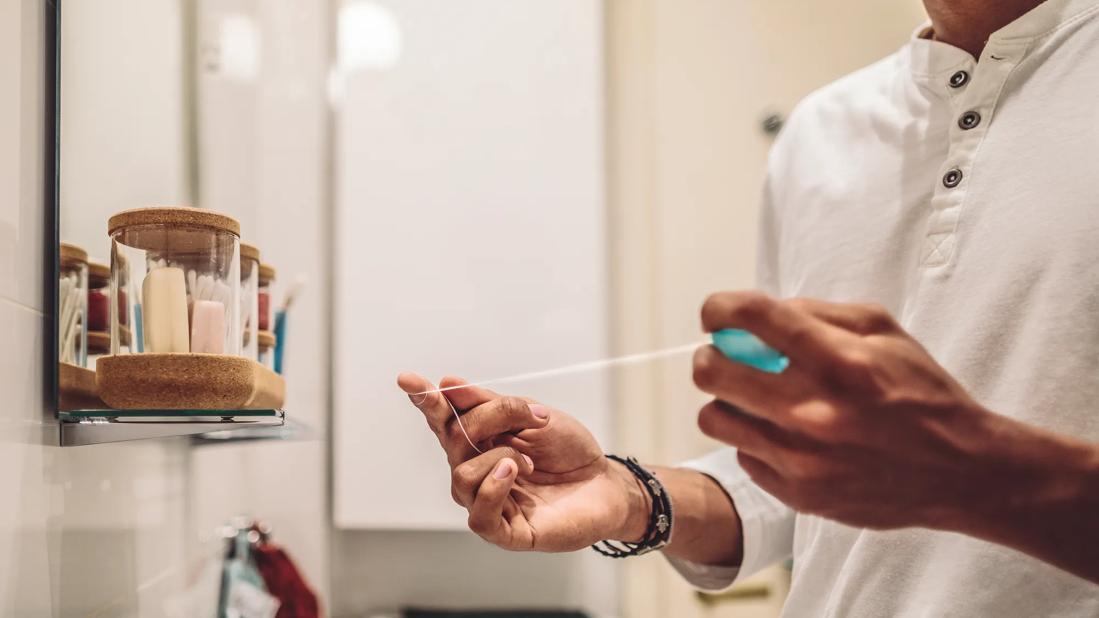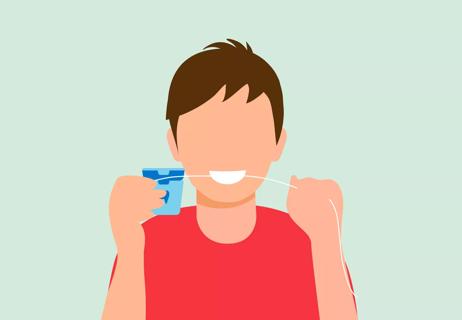Done correctly, daily flossing can help keep your teeth and gums healthy

Regular flossing is an effective way to remove dental plaque and other gunk trapped between your teeth. But the key is flossing correctly — and that’s a standard many people don’t meet.
Advertisement
Cleveland Clinic is a non-profit academic medical center. Advertising on our site helps support our mission. We do not endorse non-Cleveland Clinic products or services. Policy
“A lot of us have never really been shown how to properly floss,” says periodontist Sasha Ross, DMD, MS. “Just having your dentist or hygienist tell you to do it isn’t enough. You have to know how to do it.”
So, let’s learn.
The fact you’re reading this article is a sign that you’re on the right path to building a healthy, good oral hygiene routine. After all, it’s estimated that 1 in 5 adults NEVER floss — so, you’re already ahead!
To keep your teeth in tip-top shape, Dr. Ross recommends flossing once a day at nighttime. Brushing your teeth twice a day (when you wake up and before you go to bed) should be part of your game plan, too.
As to whether you should floss before or after brushing … well, let’s just say the important thing is that you do both, says Dr. Ross. Order doesn’t make that much of a difference. (But truth be told, flossing first has been shown to have a few more health benefits.)
Here are five steps to floss in a way that removes problematic bacteria, tartar and plaque that can build up between teeth and along your gumline.
Advertisement
Gums can be sensitive, so — as mentioned — don’t be rough on them when you floss. It’s OK to guide the floss just below your gumline to remove food particles and bacteria but avoid digging in deep.
“Make sure you’re not traumatizing your gum tissue and pressing too hard or at the wrong angle,” instructs Dr. Ross.
Overaggressive flossing could lead to floss cuts. View it as a sign to be gentler.
As an FYI, too, bleeding gums also are somewhat common if you’ve been a little lax in your flossing routine. It’s often a sign of unhealthy gums and may indicate the early stages of gum disease. (It’s estimated that 42% of adults over age 30 have some form of gum disease.)
The good news? Regular flossing can turn things around quickly. “In most cases, if you stick with flossing and use the right technique, the bleeding will stop after a week or so,” she notes.
Studies show no difference in unwaxed or waxed floss. But Dr. Ross prefers the unwaxed version. “It seems to be a little bit more effective,” she says.
But if you have braces, waxed floss may be a better choice as it’s less likely to get stuck or torn. (And while flossing with braces may be difficult and take more time given the mouth hardware, it’s still necessary.)
Although there are other flossing tools, traditional string floss works best, emphasizes Dr. Ross. Plastic dental picks are OK in a pinch (like if you have something stuck between your teeth while out to eat), but regular flossing should be done the old-fashioned way.
The exception here is if you have hand dexterity issues. “If you have a condition that keeps you from being able to grip the floss, picks are a good alternative,” she adds.
Flossing promotes healthier teeth and gums by removing hard-to-reach bacteria around your teeth. Making it a daily habit can limit your risk of cavities, as well as gingivitis and other forms of gum disease.
“Flossing is incredibly important because studies have shown that brushing just doesn’t get to the area in between your teeth,” Dr. Ross states. “If you’re not getting the plaque there, it can lead to cavities or periodontal disease or both.”
But good oral health also is about more than supporting a nice smile. Problems with your teeth and gums can lead to health concerns such as:
So, flossing is worth the effort and a few minutes of your time each day.
To perfect your flossing form, talk to your dentist or hygienist. Ask questions the next time you’re at their office. (Getting professional teeth cleanings and examinations also should be part of your oral health plan.)
Advertisement
“Lean on your dentist, periodontist or hygienist for extra instruction if you need it,” recommends Dr. Ross. “Ask them to watch how you floss. They can show you what you need to do to be more effective at cleaning your teeth.”
Advertisement
Learn more about our editorial process.
Advertisement

Bloody gums after flossing usually signal a buildup of plaque, tartar and bacteria

This tool is an add-on to your regular brushing and flossing habits, not a replacement for them

Flossing first might be a tad more beneficial, but it’s most important that you DO brush and floss

Prescription oral antivirals are your best bet, but OTC creams can help, too

You might have a sensitive gag reflex — but gagging while brushing can also be a result of certain medical conditions

Stay hydrated, use a humidifier and try sugar-free candies or over-the-counter products with xylitol

An old, worn toothbrush is a hazard to your teeth and gums and a breeding ground for germs and bacteria — replace it every three to four months at least

Wisdom teeth can cause headaches when they emerge or if they become impacted

If you’re feeling short of breath, sleep can be tough — propping yourself up or sleeping on your side may help

If you fear the unknown or find yourself needing reassurance often, you may identify with this attachment style

If you’re looking to boost your gut health, it’s better to get fiber from whole foods